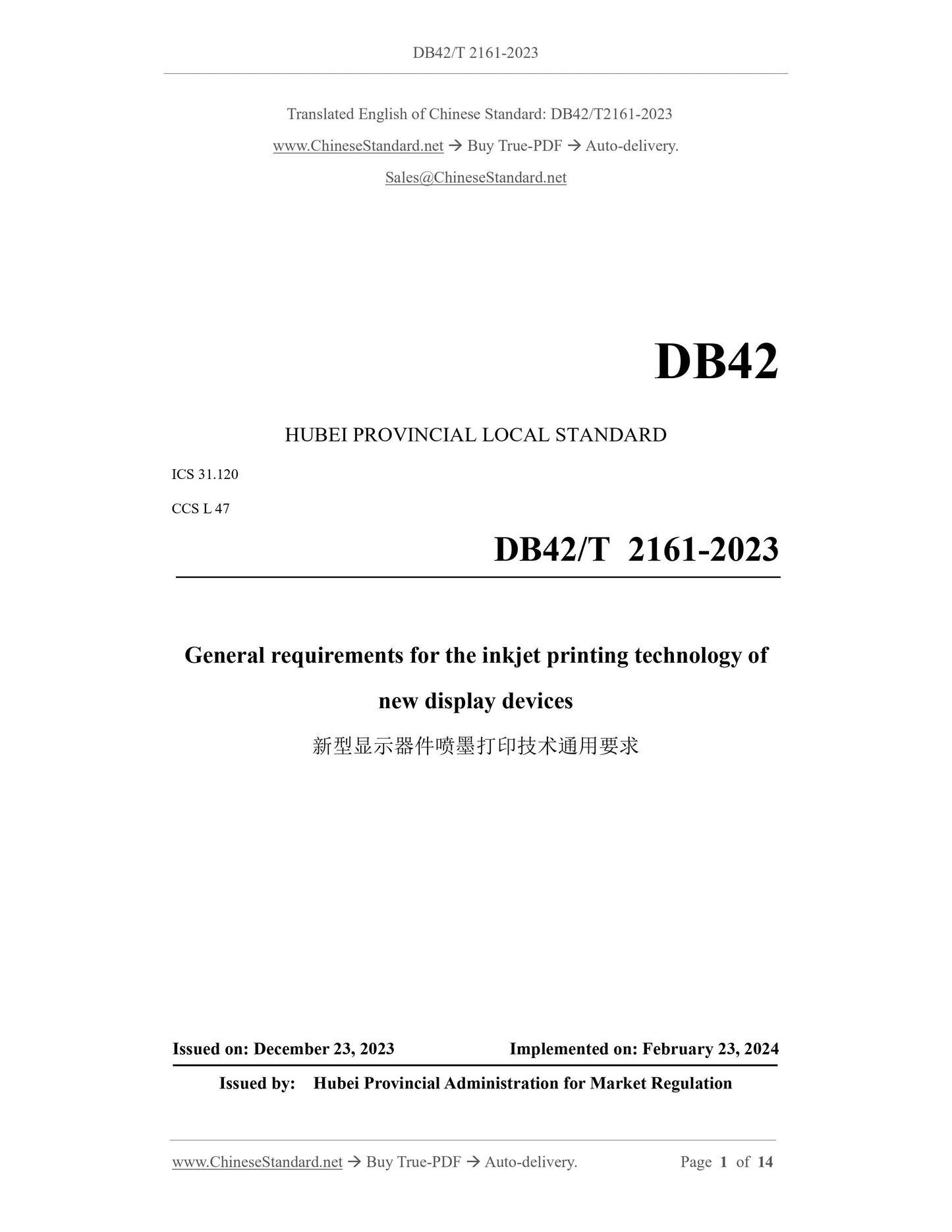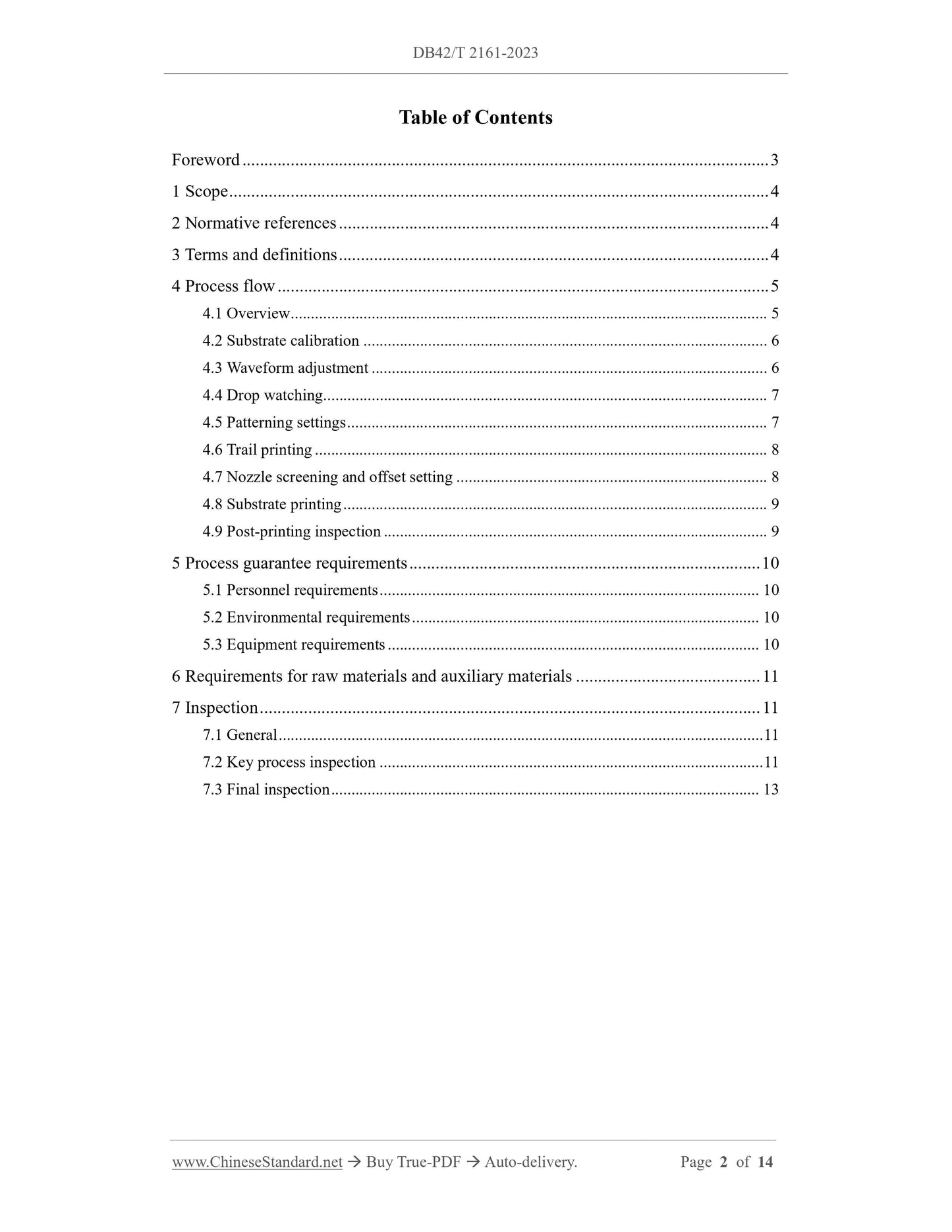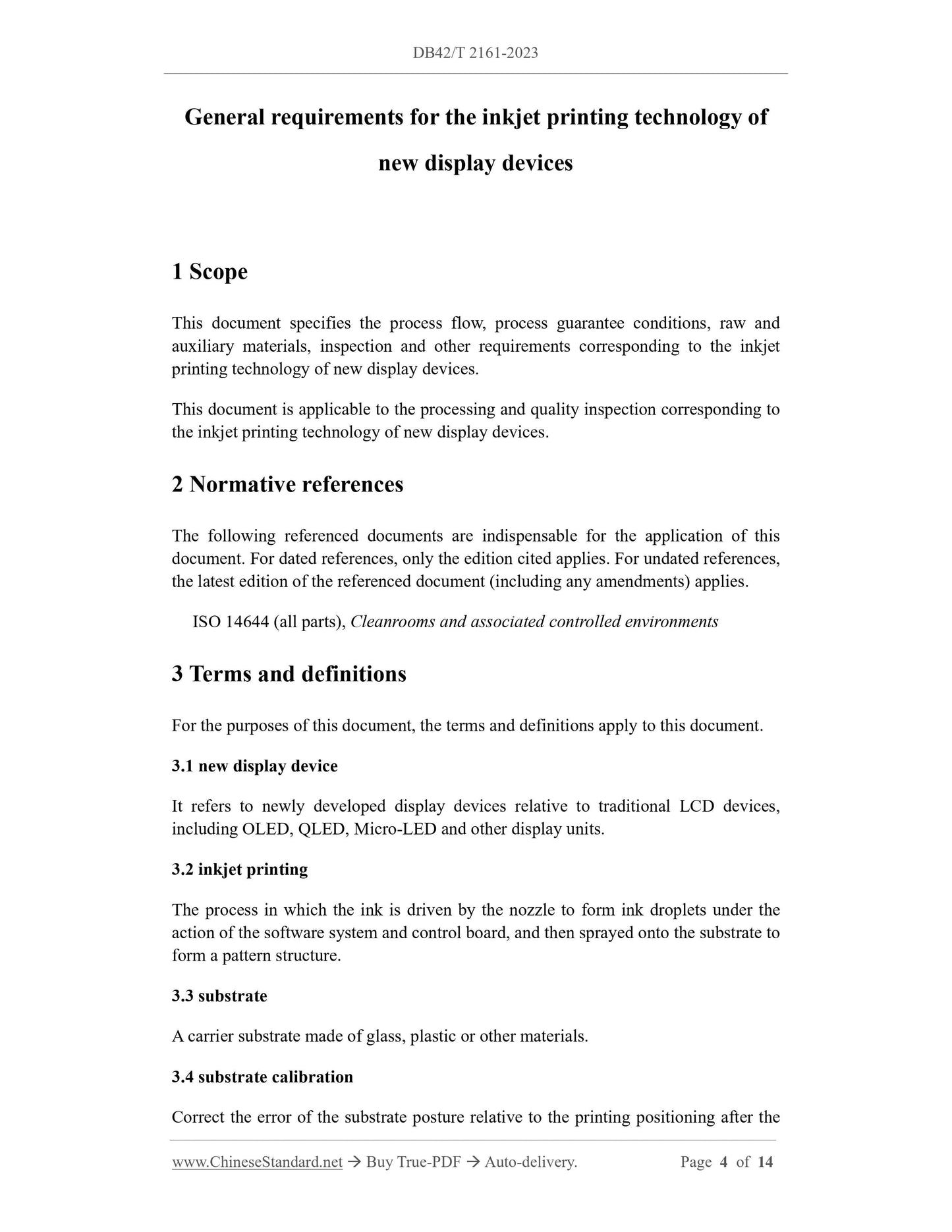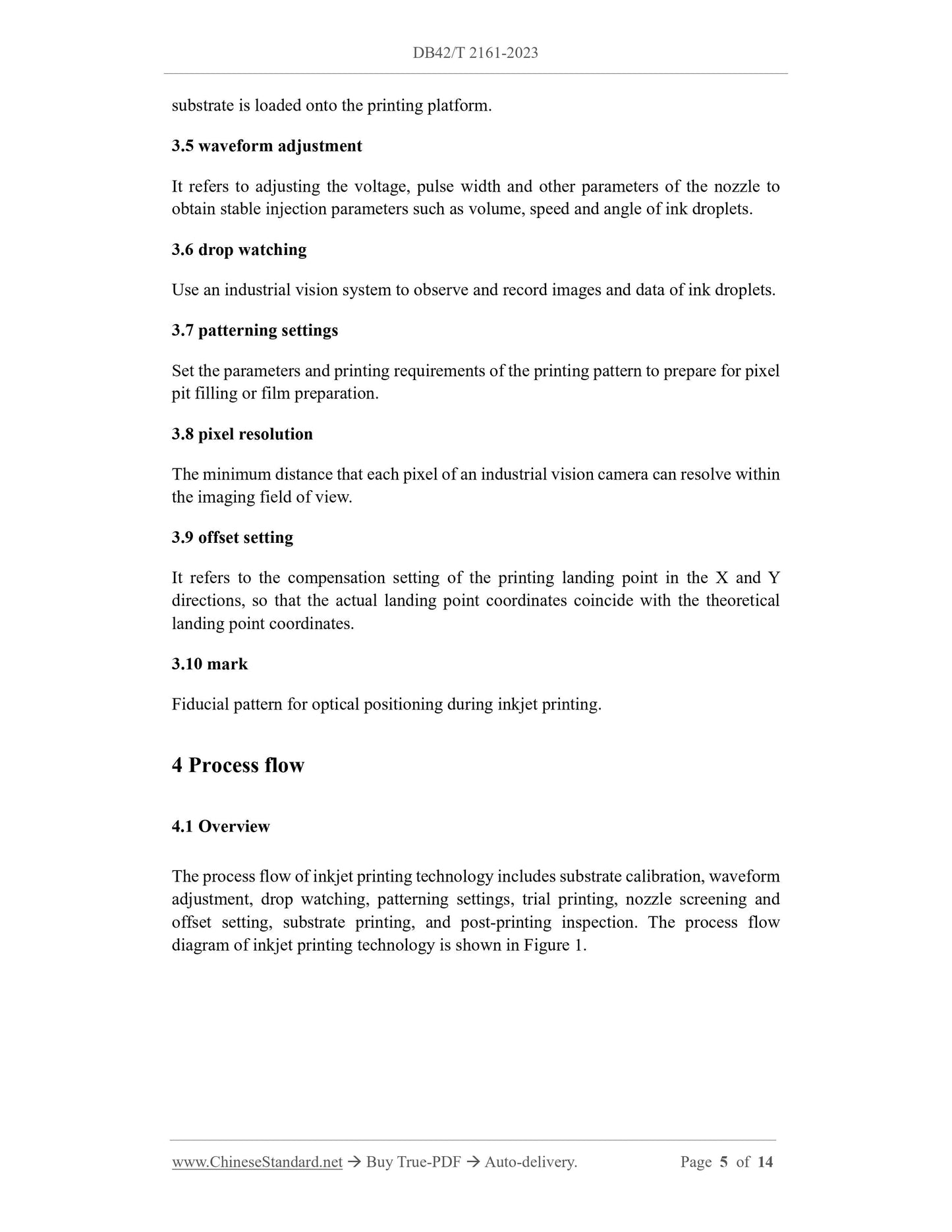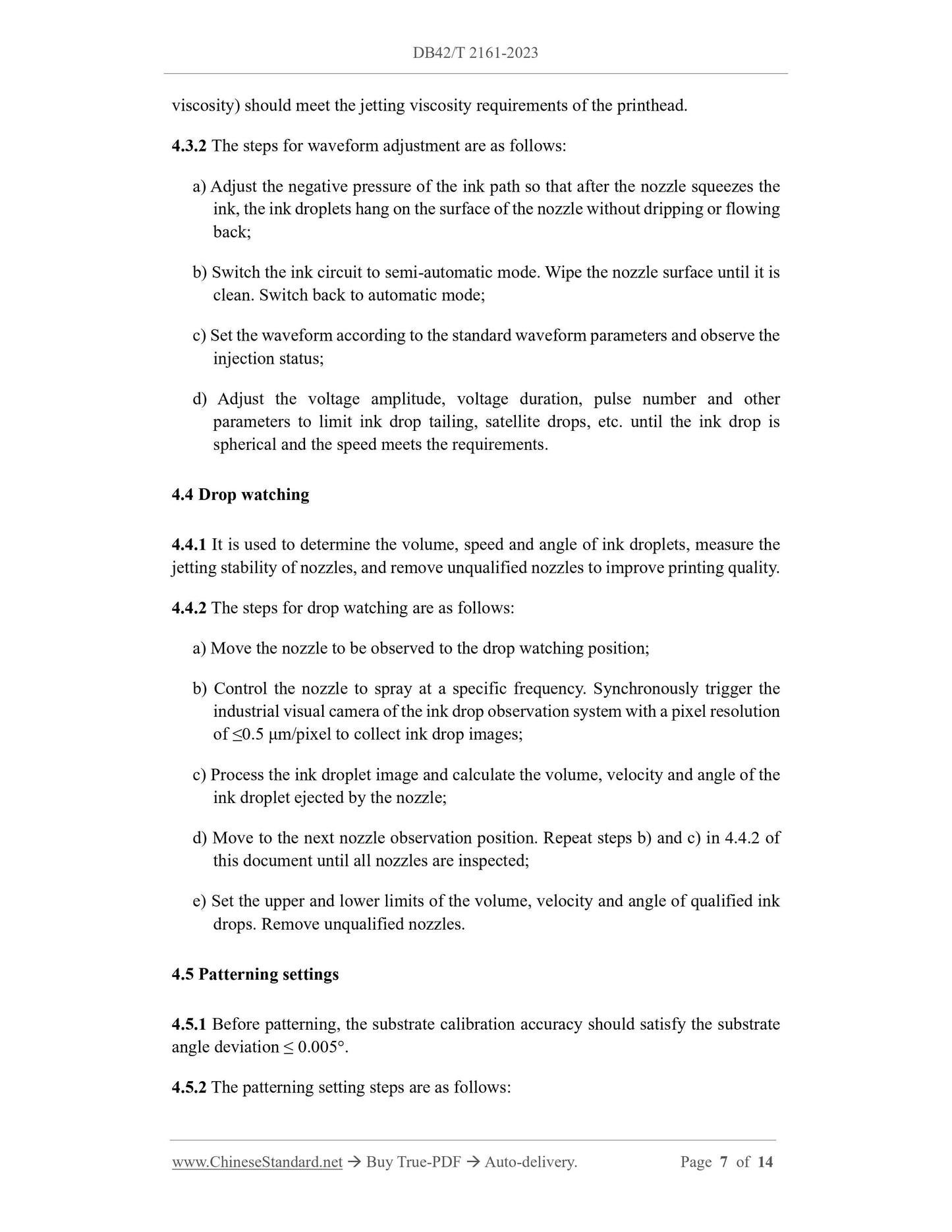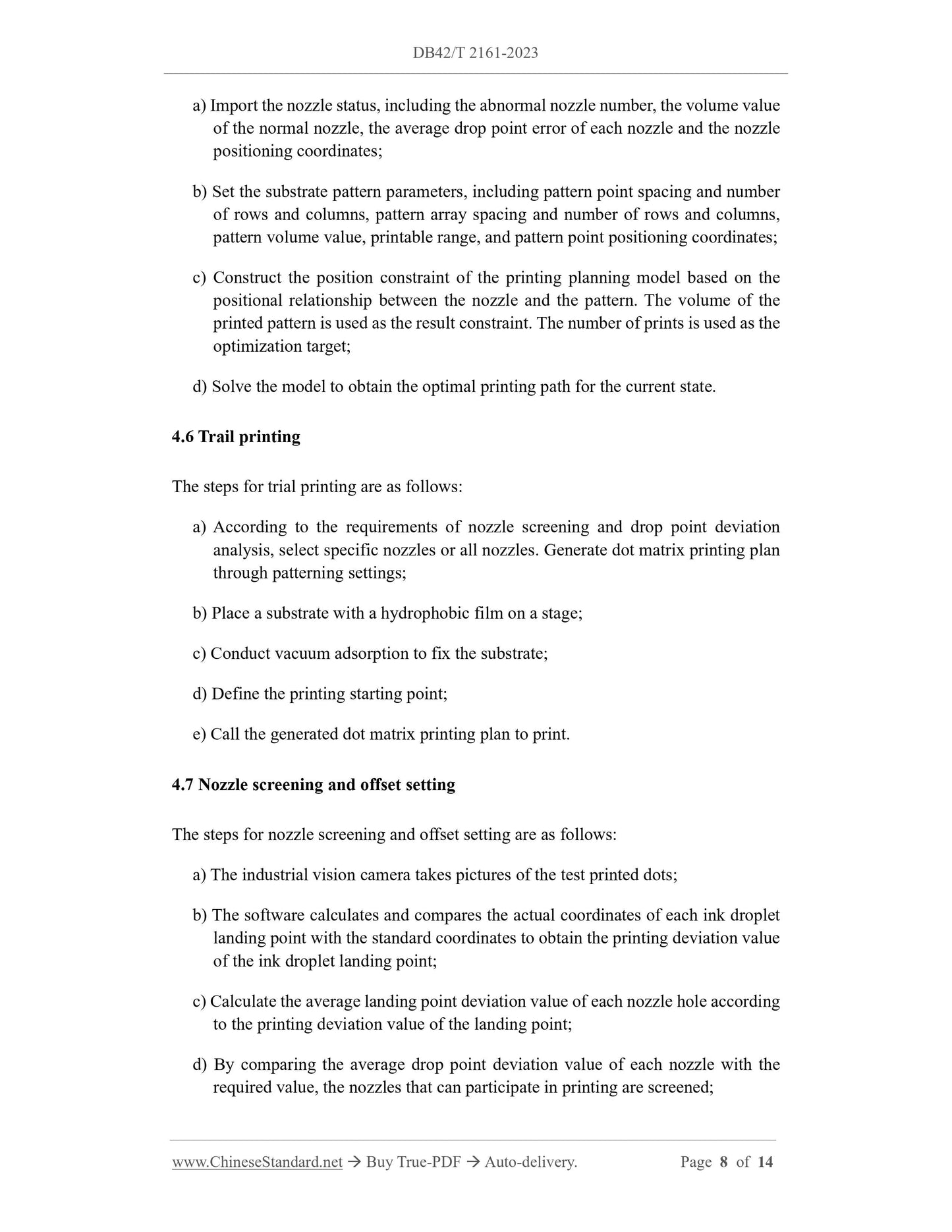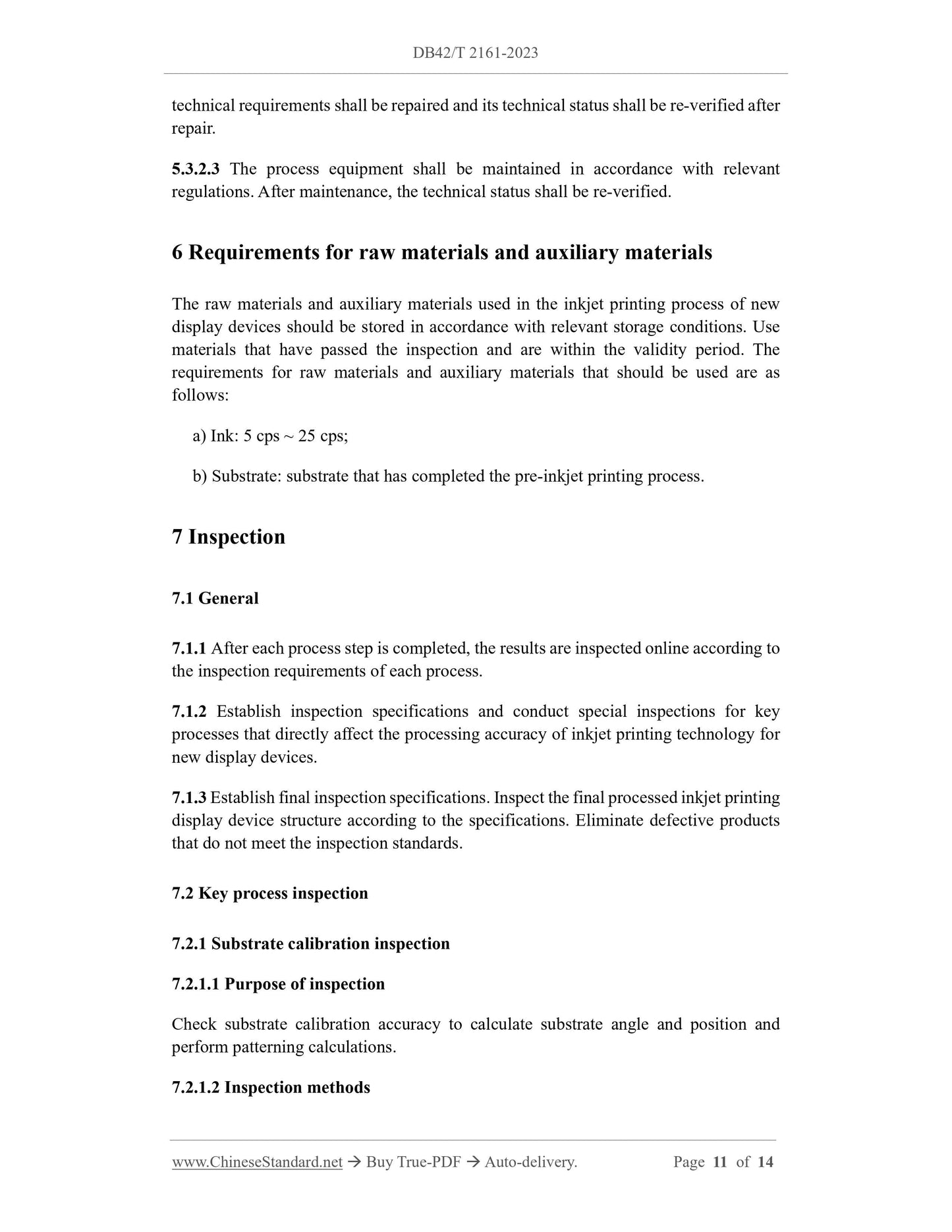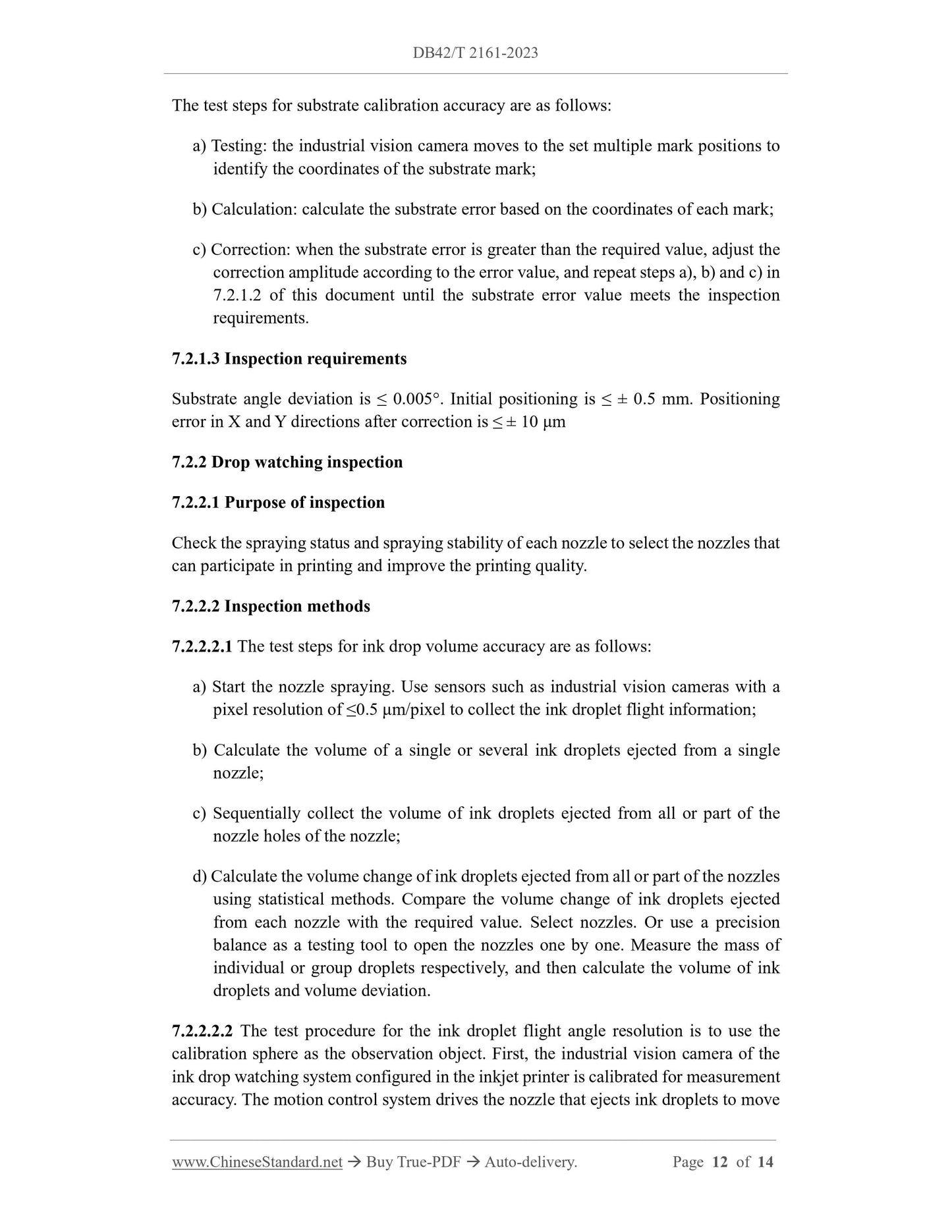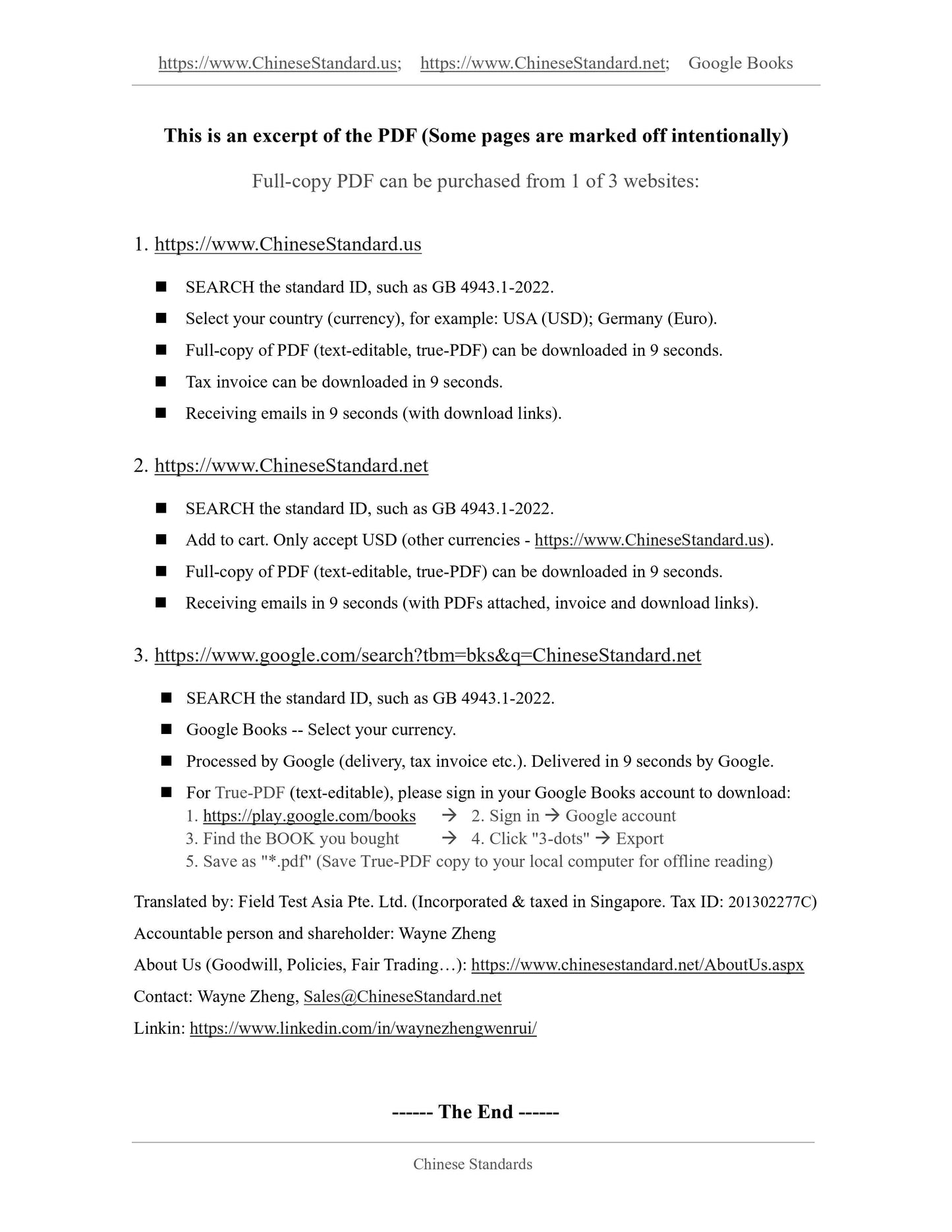1
/
su
9
PayPal, credit cards. Download editable-PDF and invoice in 1 second!
DB42/T 2161-2023 English PDF (DB42T2161-2023)
DB42/T 2161-2023 English PDF (DB42T2161-2023)
Prezzo di listino
$260.00 USD
Prezzo di listino
Prezzo scontato
$260.00 USD
Prezzo unitario
/
per
Spese di spedizione calcolate al check-out.
Impossibile caricare la disponibilità di ritiro
Delivery: 3 seconds. Download true-PDF + Invoice.
Get QUOTATION in 1-minute: Click DB42/T 2161-2023
Historical versions: DB42/T 2161-2023
Preview True-PDF (Reload/Scroll if blank)
DB42/T 2161-2023: General requirements for the inkjet printing technology of new display devices
DB42/T 2161-2023
DB42
HUBEI PROVINCIAL LOCAL STANDARD
ICS 31.120
CCS L 47
General requirements for the inkjet printing technology of
new display devices
ISSUED ON. DECEMBER 23, 2023
IMPLEMENTED ON. FEBRUARY 23, 2024
Issued by. Hubei Provincial Administration for Market Regulation
Table of Contents
Foreword... 3
1 Scope... 4
2 Normative references... 4
3 Terms and definitions... 4
4 Process flow... 5
4.1 Overview... 5
4.2 Substrate calibration... 6
4.3 Waveform adjustment... 6
4.4 Drop watching... 7
4.5 Patterning settings... 7
4.6 Trail printing... 8
4.7 Nozzle screening and offset setting... 8
4.8 Substrate printing... 9
4.9 Post-printing inspection... 9
5 Process guarantee requirements... 10
5.1 Personnel requirements... 10
5.2 Environmental requirements... 10
5.3 Equipment requirements... 10
6 Requirements for raw materials and auxiliary materials... 11
7 Inspection... 11
7.1 General... 11
7.2 Key process inspection... 11
7.3 Final inspection... 13
General requirements for the inkjet printing technology of
new display devices
1 Scope
This document specifies the process flow, process guarantee conditions, raw and
auxiliary materials, inspection and other requirements corresponding to the inkjet
printing technology of new display devices.
This document is applicable to the processing and quality inspection corresponding to
the inkjet printing technology of new display devices.
2 Normative references
The following referenced documents are indispensable for the application of this
document. For dated references, only the edition cited applies. For undated references,
the latest edition of the referenced document (including any amendments) applies.
ISO 14644 (all parts), Cleanrooms and associated controlled environments
3 Terms and definitions
For the purposes of this document, the terms and definitions apply to this document.
3.1 new display device
It refers to newly developed display devices relative to traditional LCD devices,
including OLED, QLED, Micro-LED and other display units.
3.2 inkjet printing
The process in which the ink is driven by the nozzle to form ink droplets under the
action of the software system and control board, and then sprayed onto the substrate to
form a pattern structure.
3.3 substrate
A carrier substrate made of glass, plastic or other materials.
3.4 substrate calibration
Correct the error of the substrate posture relative to the printing positioning after the
substrate is loaded onto the printing platform.
3.5 waveform adjustment
It refers to adjusting the voltage, pulse width and other parameters of the nozzle to
obtain stable injection parameters such as volume, speed and angle of ink droplets.
3.6 drop watching
Use an industrial vision system to observe and record images and data of ink droplets.
3.7 patterning settings
Set the parameters and printing requirements of the printing pattern to prepare for pixel
pit filling or film preparation.
3.8 pixel resolution
The minimum distance that each pixel of an industrial vision camera can resolve within
the imaging field of view.
3.9 offset setting
It refers to the compensation setting of the printing landing point in the X and Y
directions, so that the actual landing point coordinates coincide with the theoretical
landing point coordinates.
3.10 mark
Fiducial pattern for optical positioning during inkjet printing.
4 Process flow
4.1 Overview
The process flow of inkjet printing technology includes substrate calibration, waveform
adjustment, drop watching, patterning settings, trial printing, nozzle screening and
offset setting, substrate printing, and post-printing inspection. The process flow
diagram of inkjet printing technology is shown in Figure 1.
viscosity) should meet the jetting viscosity requirements of the printhead.
4.3.2 The steps for waveform adjustment are as follows.
a) Adjust the negative pressure of the ink path so that after the nozzle squeezes the
ink, the ink droplets hang on the surface of the nozzle without dripping or flowing
back;
b) Switch the ink circuit to semi-automatic mode. Wipe the nozzle surface until it is
clean. Switch back to automatic mode;
c) Set the waveform according to the standard waveform parameters and observe the
injection status;
d) Adjust the voltage amplitude, voltage duration, pulse number and other
parameters to limit ink drop tailing, satellite drops, etc. until the ink drop is
spherical and the speed meets the requirements.
4.4 Drop watching
4.4.1 It is used to determine the volume, speed and angle of ink droplets, measure the
jetting stability of nozzles, and remove unqualified nozzles to improve printing quality.
4.4.2 The steps for drop watching are as follows.
a) Move the nozzle to be observed to the drop watching position;
b) Control the nozzle to spray at a specific frequency. Synchronously trigger the
industrial visual camera of the ink drop observation system with a pixel resolution
of ≤0.5 μm/pixel to collect ink drop images;
c) Process the ink droplet image and calculate the volume, velocity and angle of the
ink droplet ejected by the nozzle;
d) Move to the next nozzle observation position. Repeat steps b) and c) in 4.4.2 of
this document until all nozzles are inspected;
e) Set the upper and lower limits of the volume, velocity and angle of qualified ink
drops. Remove unqualified nozzles.
4.5 Patterning settings
4.5.1 Before patterning, the substrate calibration accuracy should satisfy the substrate
angle deviation ≤ 0.005°.
4.5.2 The patterning setting steps are as follows.
a) Import the nozzle status, including the abnormal nozzle number, the volume value
of the normal nozzle, the average drop point error of each nozzle and the nozzle
positioning coordinates;
b) Set the substrate pattern parameters, including pattern point spacing and number
of rows and columns, pattern array spacing and number of rows and columns,
pattern volume value, printable range, and pattern point positioning coordinates;
c) Construct the position constraint of the printing planning model based on the
positional relationship between the nozzle and the pattern. The volume of the
printed pattern is used as the result constraint. The number of prints is used as the
optimization target;
d) Solve the model to obtain the optimal printing path for the current state.
4.6 Trail printing
The steps for trial printing are as follows.
a) According to the requirements of nozzle screening and drop point deviation
analysis, select specific nozzles or all nozzles. Generate dot matrix printing plan
through patterning settings;
b) Place a substrate with a hydrophobic film on a stage;
c) Conduct vacuum adsorption to fix the substrate;
d) Define the printing starting point;
e) Call the generated dot matrix printing plan to print.
4.7 Nozzle screening and offset setting
The steps for nozzle screening and offset setting are as follows.
a) The industrial vision camera takes pictures of the test printed dots;
b) The software calculates and compares the actual coordinates of each ink droplet
landing point with the standard coordinates to obtain the printing deviation value
of the ink droplet landing point;
c) Calculate the average landing ...
Get QUOTATION in 1-minute: Click DB42/T 2161-2023
Historical versions: DB42/T 2161-2023
Preview True-PDF (Reload/Scroll if blank)
DB42/T 2161-2023: General requirements for the inkjet printing technology of new display devices
DB42/T 2161-2023
DB42
HUBEI PROVINCIAL LOCAL STANDARD
ICS 31.120
CCS L 47
General requirements for the inkjet printing technology of
new display devices
ISSUED ON. DECEMBER 23, 2023
IMPLEMENTED ON. FEBRUARY 23, 2024
Issued by. Hubei Provincial Administration for Market Regulation
Table of Contents
Foreword... 3
1 Scope... 4
2 Normative references... 4
3 Terms and definitions... 4
4 Process flow... 5
4.1 Overview... 5
4.2 Substrate calibration... 6
4.3 Waveform adjustment... 6
4.4 Drop watching... 7
4.5 Patterning settings... 7
4.6 Trail printing... 8
4.7 Nozzle screening and offset setting... 8
4.8 Substrate printing... 9
4.9 Post-printing inspection... 9
5 Process guarantee requirements... 10
5.1 Personnel requirements... 10
5.2 Environmental requirements... 10
5.3 Equipment requirements... 10
6 Requirements for raw materials and auxiliary materials... 11
7 Inspection... 11
7.1 General... 11
7.2 Key process inspection... 11
7.3 Final inspection... 13
General requirements for the inkjet printing technology of
new display devices
1 Scope
This document specifies the process flow, process guarantee conditions, raw and
auxiliary materials, inspection and other requirements corresponding to the inkjet
printing technology of new display devices.
This document is applicable to the processing and quality inspection corresponding to
the inkjet printing technology of new display devices.
2 Normative references
The following referenced documents are indispensable for the application of this
document. For dated references, only the edition cited applies. For undated references,
the latest edition of the referenced document (including any amendments) applies.
ISO 14644 (all parts), Cleanrooms and associated controlled environments
3 Terms and definitions
For the purposes of this document, the terms and definitions apply to this document.
3.1 new display device
It refers to newly developed display devices relative to traditional LCD devices,
including OLED, QLED, Micro-LED and other display units.
3.2 inkjet printing
The process in which the ink is driven by the nozzle to form ink droplets under the
action of the software system and control board, and then sprayed onto the substrate to
form a pattern structure.
3.3 substrate
A carrier substrate made of glass, plastic or other materials.
3.4 substrate calibration
Correct the error of the substrate posture relative to the printing positioning after the
substrate is loaded onto the printing platform.
3.5 waveform adjustment
It refers to adjusting the voltage, pulse width and other parameters of the nozzle to
obtain stable injection parameters such as volume, speed and angle of ink droplets.
3.6 drop watching
Use an industrial vision system to observe and record images and data of ink droplets.
3.7 patterning settings
Set the parameters and printing requirements of the printing pattern to prepare for pixel
pit filling or film preparation.
3.8 pixel resolution
The minimum distance that each pixel of an industrial vision camera can resolve within
the imaging field of view.
3.9 offset setting
It refers to the compensation setting of the printing landing point in the X and Y
directions, so that the actual landing point coordinates coincide with the theoretical
landing point coordinates.
3.10 mark
Fiducial pattern for optical positioning during inkjet printing.
4 Process flow
4.1 Overview
The process flow of inkjet printing technology includes substrate calibration, waveform
adjustment, drop watching, patterning settings, trial printing, nozzle screening and
offset setting, substrate printing, and post-printing inspection. The process flow
diagram of inkjet printing technology is shown in Figure 1.
viscosity) should meet the jetting viscosity requirements of the printhead.
4.3.2 The steps for waveform adjustment are as follows.
a) Adjust the negative pressure of the ink path so that after the nozzle squeezes the
ink, the ink droplets hang on the surface of the nozzle without dripping or flowing
back;
b) Switch the ink circuit to semi-automatic mode. Wipe the nozzle surface until it is
clean. Switch back to automatic mode;
c) Set the waveform according to the standard waveform parameters and observe the
injection status;
d) Adjust the voltage amplitude, voltage duration, pulse number and other
parameters to limit ink drop tailing, satellite drops, etc. until the ink drop is
spherical and the speed meets the requirements.
4.4 Drop watching
4.4.1 It is used to determine the volume, speed and angle of ink droplets, measure the
jetting stability of nozzles, and remove unqualified nozzles to improve printing quality.
4.4.2 The steps for drop watching are as follows.
a) Move the nozzle to be observed to the drop watching position;
b) Control the nozzle to spray at a specific frequency. Synchronously trigger the
industrial visual camera of the ink drop observation system with a pixel resolution
of ≤0.5 μm/pixel to collect ink drop images;
c) Process the ink droplet image and calculate the volume, velocity and angle of the
ink droplet ejected by the nozzle;
d) Move to the next nozzle observation position. Repeat steps b) and c) in 4.4.2 of
this document until all nozzles are inspected;
e) Set the upper and lower limits of the volume, velocity and angle of qualified ink
drops. Remove unqualified nozzles.
4.5 Patterning settings
4.5.1 Before patterning, the substrate calibration accuracy should satisfy the substrate
angle deviation ≤ 0.005°.
4.5.2 The patterning setting steps are as follows.
a) Import the nozzle status, including the abnormal nozzle number, the volume value
of the normal nozzle, the average drop point error of each nozzle and the nozzle
positioning coordinates;
b) Set the substrate pattern parameters, including pattern point spacing and number
of rows and columns, pattern array spacing and number of rows and columns,
pattern volume value, printable range, and pattern point positioning coordinates;
c) Construct the position constraint of the printing planning model based on the
positional relationship between the nozzle and the pattern. The volume of the
printed pattern is used as the result constraint. The number of prints is used as the
optimization target;
d) Solve the model to obtain the optimal printing path for the current state.
4.6 Trail printing
The steps for trial printing are as follows.
a) According to the requirements of nozzle screening and drop point deviation
analysis, select specific nozzles or all nozzles. Generate dot matrix printing plan
through patterning settings;
b) Place a substrate with a hydrophobic film on a stage;
c) Conduct vacuum adsorption to fix the substrate;
d) Define the printing starting point;
e) Call the generated dot matrix printing plan to print.
4.7 Nozzle screening and offset setting
The steps for nozzle screening and offset setting are as follows.
a) The industrial vision camera takes pictures of the test printed dots;
b) The software calculates and compares the actual coordinates of each ink droplet
landing point with the standard coordinates to obtain the printing deviation value
of the ink droplet landing point;
c) Calculate the average landing ...
Share
